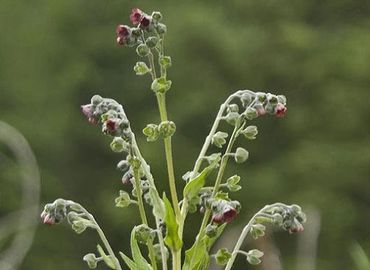Houndstongue







Details and Information
Common Names
Beggar's lice, Gypsy flower, rats and mice and dog bur
Description
Houndstongue is a biennial forb that forms a deep tap root and basal rosette the first year. The second year it forms a flowering stem. The rosette leaves are broad, oblong, petioled and resemble a dog's tongue in shape. Leaves are alternate and are soft and have a velvety touch. The second year stems form and often branch at the tip of the plant. The plants can grow up to 4 feet in height. The flowers are five petaled, reddish-purple in color and produce four triangular, rounded seeds. Houndstongue usually blooms in June and July. The seeds are small brown nutlet about 1/3 inches in length that easily attach to animals, vehicles and humans. The single tap root of this plant is thick, black and woody. Houndstongue reproduces from seed only and each plant can produce up to 2,000 seeds. This plant will die after its second year.
Key Features
The soft white hairs covering the plant, the basal leaves that resemble a hounds tongue and the little brown burs that will stick to everything.
Habitat
Houndstongue prefers well drained, relatively sandy and gravelly soils. It can be found in shady areas and especially under the canopy of forests and wetter grasslands, pastures, meadows, roadsides, and in disturbed sites.
Control
There are herbicides and other control methods that commonly control houndstongue. One of the most effective control practices is hand pulling or digging during the basal growth stage, making sure to pull up by roots or chop below growing point. Doing this will prevent further spread and can eradicate small populations. Herbicides that can be effective include Milestone, Tordon, Escort, and 2,4-D - a combination can be more effective. For more information on these herbicides and other control methods contact the Weed and Pest office.
Other Facts
Houndstongue carries an alkaloid poison that can kill livestock through the loss of production of liver cells. Animals don't normally graze on it, but if cured in hay it will remain toxic. Sheep are more resistant to Houndstongue than cattle and horses. Horses are susceptible and symptoms of ingestion include weight loss, diarrhea, convulsions and even coma. Houndstongue has been used as a remedy to acne, corn callus, eczema and fever remedy. Houndstongue seeds were the inspiration for the invention of velcro.
Cookie Policy
This website uses cookies. By continuing to use this site, you accept our use of cookies.